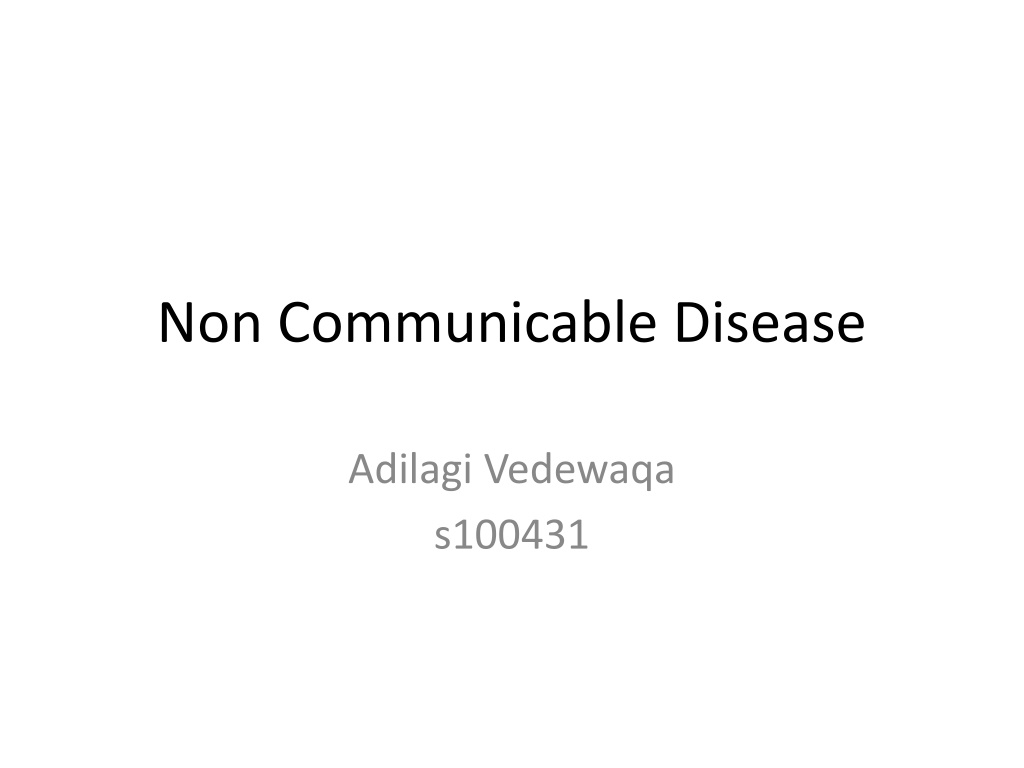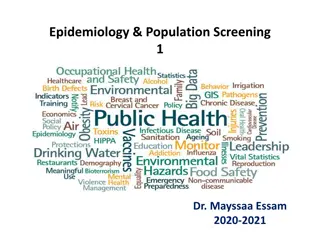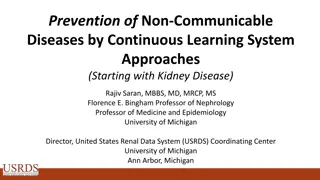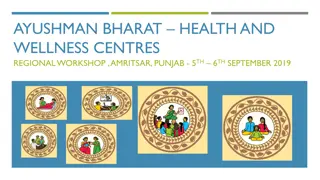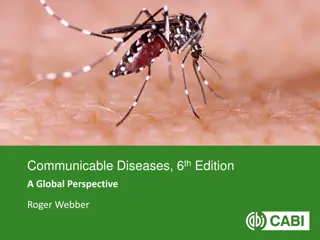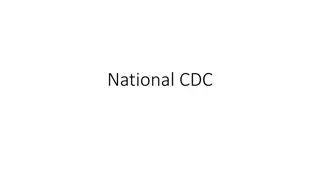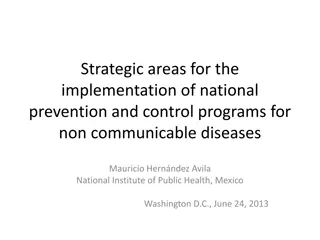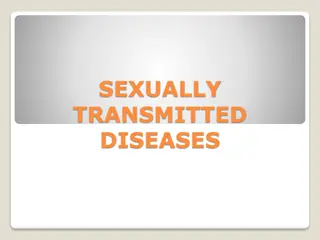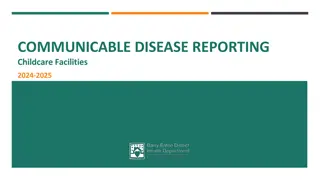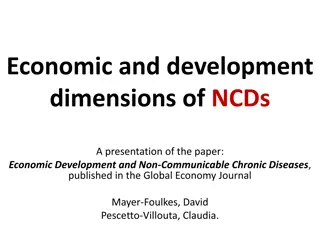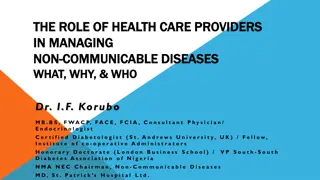Understanding Non-Communicable Diseases and Global Action Plans
Non-communicable diseases (NCDs), such as cardiovascular diseases, cancers, chronic respiratory diseases, and diabetes, pose a major health threat globally, with 38 million deaths yearly. The Global Action Plan aims to reduce premature mortality from NCDs by 2025 through specific targets, including addressing risk factors like physical inactivity, tobacco use, and unhealthy diets. The rise of NCDs in Pacific Island nations underscores the need for urgent lifestyle changes to combat this growing burden on health systems and individuals.
Download Presentation

Please find below an Image/Link to download the presentation.
The content on the website is provided AS IS for your information and personal use only. It may not be sold, licensed, or shared on other websites without obtaining consent from the author. Download presentation by click this link. If you encounter any issues during the download, it is possible that the publisher has removed the file from their server.
E N D
Presentation Transcript
Non Communicable Disease Adilagi Vedewaqa s100431
Introduction Non communicable diseases (NCDs) also known as chronic diseases, are not passed from person to person. They are of long duration and slow progressing. Children, adults and the elderly are vulnerable to the risk factors that contribute to NCDs, whether from unhealthy diets, physical inactivity, exposure to tobacco smoke or the effects of harmful use of alcohol.
Global NCDs kills 38m people each year, almost of NCD deaths occur in low and middle income countries NCDs: mainly cardiovascular diseases, cancers, chronic respiratory diseases and diabetes are the worlds largest killers. These 4 groups of diseases account for 82% of all NCD deaths. Causes premature death among adults aged 40 - 69
Global Action Plan GAP was endorsed by the World Health Assembly for the prevention for the prevention and control of NCDs by 2025. Monitoring and reporting of the 9 global NCD targets and 25% reduction in relative premature mortality from NCDs by 2025.
9 Global Targets A 25% relative reduction in risk of premature mortality from cardiovascular diseases, cancer, diabetes or chronic respiratory diseases At least 10% relative reduction in the harmful use of alcohol, as appropriate within national context A 10% relative reduction in prevalence of insufficient physical activity A 30% relative reduction in mean population intake of salt/sodium A 30% relative reduction in prevalence of current tobacco use in persons aged 15+ years A 25% relative reduction in the prevalence of raised BP or contain the prevalence of raised BP, according to national circumstances HALT THE RISE in diabetes and obesity At least 50% of eligible people receive drug therapy and counselling (including glycemic control) to prevent heart attacks and stroke An 80% availability of the affordable basic technologies and essential medicines, including generics, required to treat major NCDs in both public and private facilities.
National NCD has been on the rise in Pacific Island nations The rising urbanization and globalization has added to the rise in NCD lifestyle changes creating unhealthy habits which include increasing incidences of overweight, obesity and micronutrient deficiencies. More and more people have been affected placing burden on the economy, the health system, families and to the individuals themselves.
Fiji, health care costs for NCDs can quickly drain household resources, driving families into poverty. The excessive cost of NCDs due to lengthy and expensive treatment forces people into poverty stifling development. 82% of deaths in Fiji are attributed to NCDs. It is evident that through lifestyle, we have succumbed to developing NCD proving that while this is so, it is still preventable.
The five (5) strategic action areas along an intervention pathway that corresponds to the NCD causation pathway 1] Environmental Level - through policy and regulatory intervention 2] Lifestyle Intervention - population based at the level of common and intermediate risk factors 3] Clinical Intervention - at the level of early and established diseases 4] Advocacy - providing strategic actions in social mobilization, public education/ outreach, risk communication and advocacy for policy change that are relevant to NCDs. 5] Surveillance, Research and Evaluation - through STEPS SURVEY, MINI STEPS
Healthy Public Policies: create public health policies that promote NCD prevention and control Reduce tobacco prevalence with Tobacco Free Initiatives Promote healthy diets in line with Fiji Food and Nutrition Policy and Food Based Dietary Guidelines Development of an Alcohol Control regulation Fiji Plan of Action on Physical Activity
Create supportive environment: increase the number of NO SMOKING PUBLIC PLACES. Reduce high levels of exposure of children and young people to second hand smoke at home and public places. School canteens to promote healthy and nutritious snack Limit time for kava and alcohol consumption Create opportunities for increasing physical activity-backyard gardening
Strengthen community actions: Supporting local community participation in policy development and implementation Empower communities- their ownership and control of their destinies Enhancing community self-help and social support Providing full and continuous access to information, learning opportunity for health, as well as funding support. CHWs-ensure accessibility and prevent groups or individuals in communities or villages from being deprived of health services
Develop personal skills Providing information on NCDs which increases options available to people to take control of their own health and over their environments and make choices conducive to health Facilitated at school, home, work and community settings Home Gardening project Re-orient health systems to address the needs of people with such disease Individuals, communities, health professionals and health service institutions must work towards a health care system which contributes to the pursuit of health. Move more towards health promotion apart from providing clinical and curative services.
To lessen the impact of NCDs on individuals and society, a comprehensive approach is needed that requires all sectors, including health, finance, foreign affairs, education, agriculture, planning and others, to work together to reduce the risks associated with NCDs, as well as promote the interventions to prevent and control them.
References 1. Non Communicable Disease [Internet].2015 Available from: http://www.who.int/mediacentre/factsheet/fs3 55/en/ 2. Global Action Plan for the Prevention and Control of Non Communicable Diseases. Geneva; 2013 3. Non Communicable Diseases Prevention and Control Strategic Plan 2010-2014. Fiji: Ministry of Health
Lifestyle factors Genes load the gun, lifestyle pulls the trigger.
